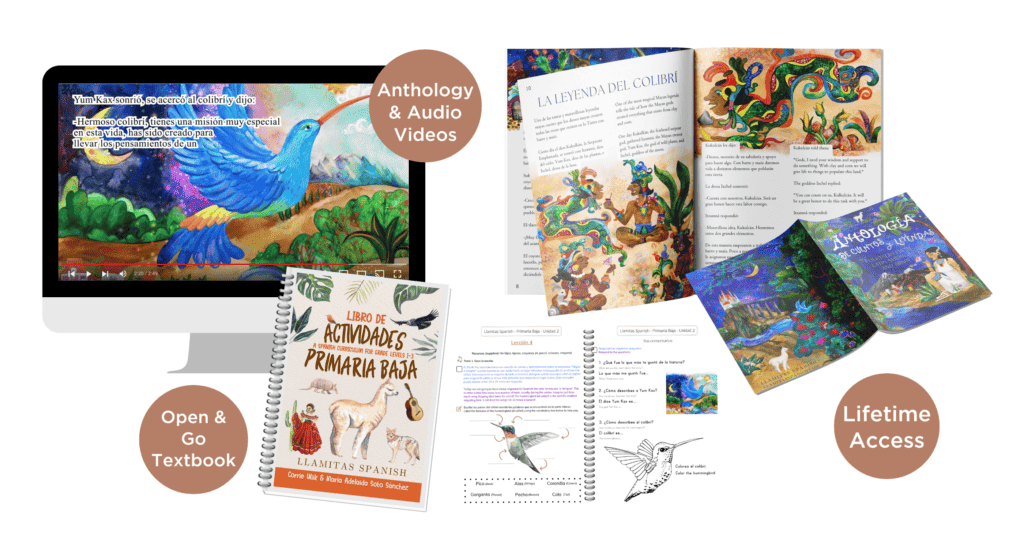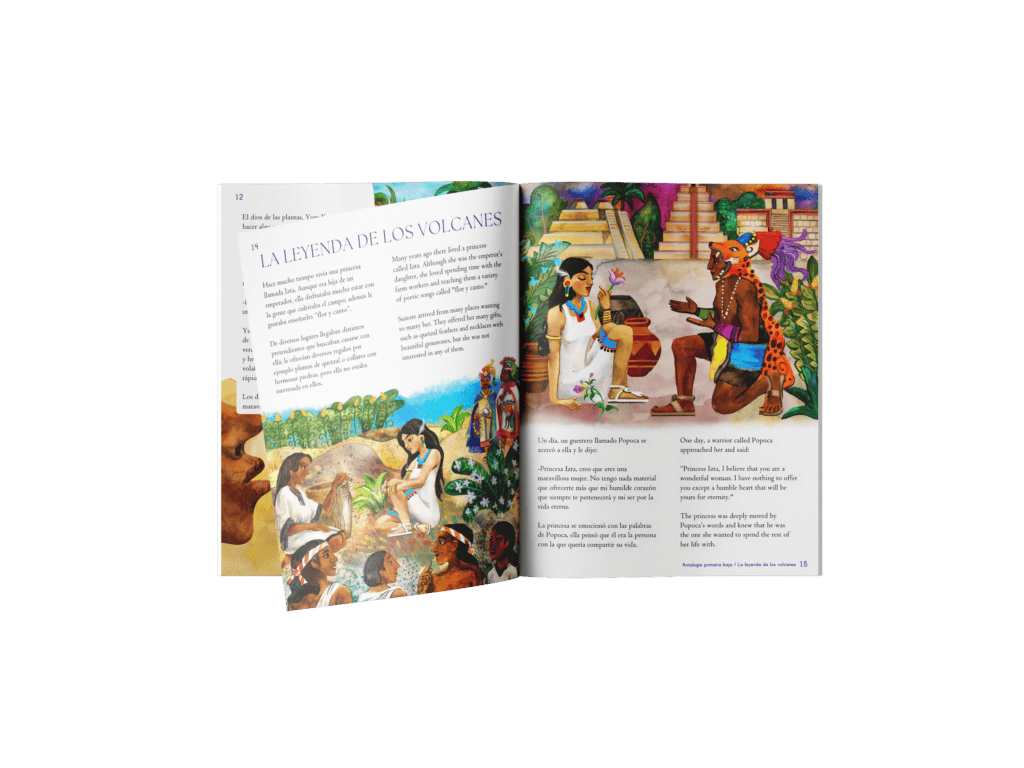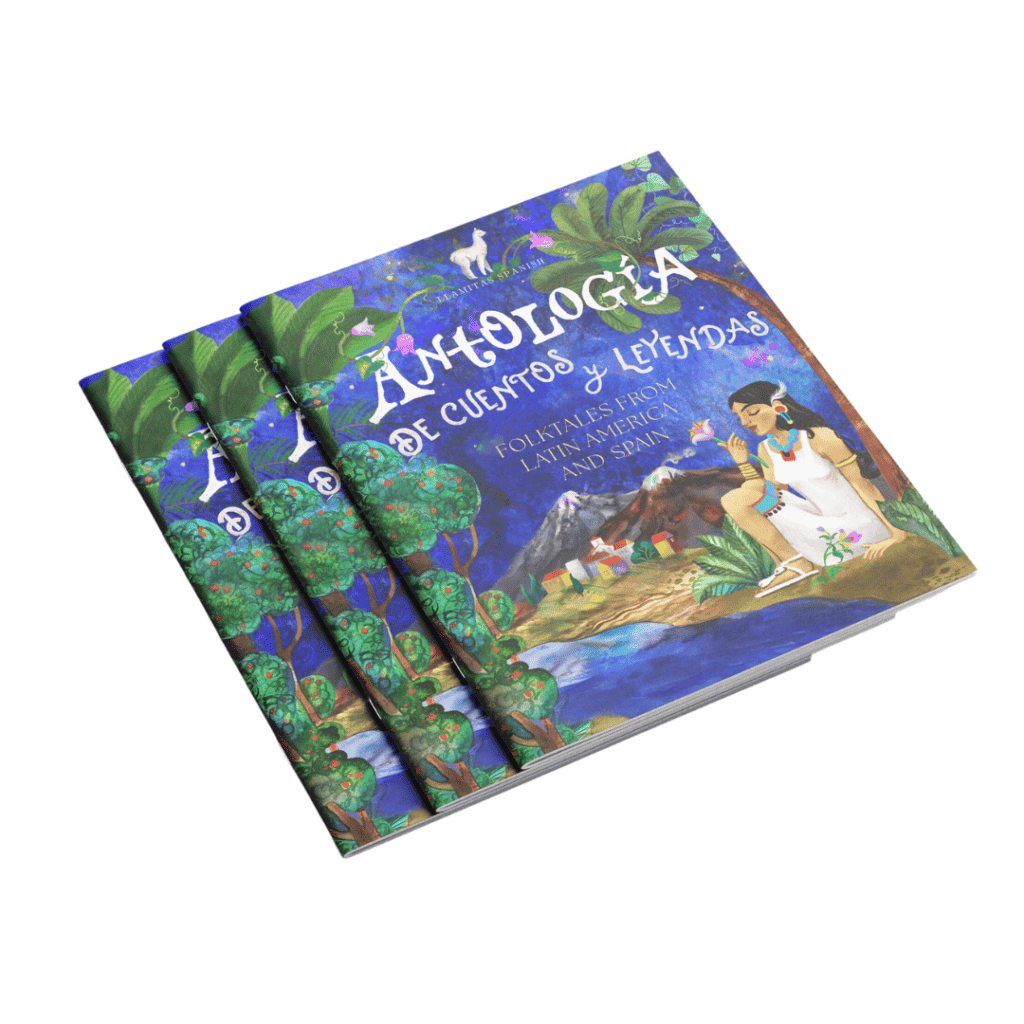In this post: A round-up of authentic and traditional Latin American and Spanish folktales that your kids will love.
One great way to practice Spanish at home while also providing cultural context for the language is to share folktales and legends in Spanish.
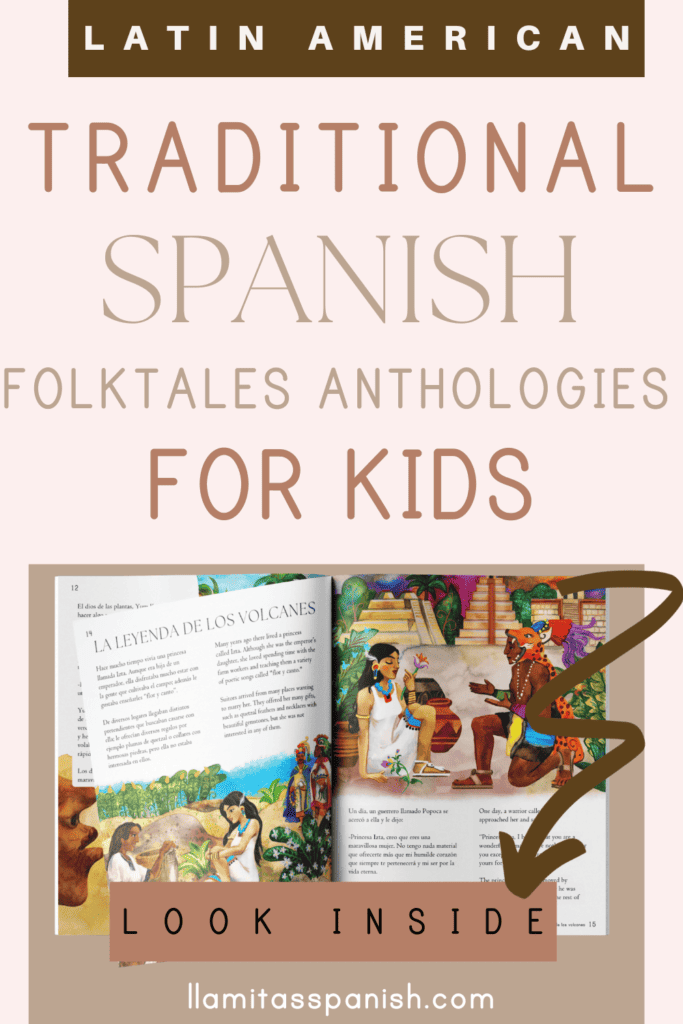
This post contains affiliate links. As an Amazon associate I earn from qualifying purchases.
Parents can help to round out their children’s Spanish education by enrolling in our authentic Llamitas Spanish Curriculum. Rooted in the Hispanic culture, it is packed with thematic lessons, songs, bilingual readers, games and so much more!
Our level 2 curriculum for elementary grades includes a beautiful anthology with six Latin American and Spanish folktales!
Table of Contents
What are folktales?
Folktales, sometimes called leyendas, relatos populares, or cuentos folklóricos, are fantasy stories that have been handed down from generation to generation.
Sometimes they spread far beyond national borders and appear in more than one country, often with a few variations in the tale.
Traditional Spanish and Latin American folktales provide an amazing treasure trove of creative ideas for enhancing your kids’ Spanish education.
These tales typically include colorful characters, unpredictable story-lines, and moralistic conclusions that often help us to determine right from wrong.
Why should we read folktales to our children?
Folktales are meaningful cultural markers because they teach us about our heritage and the belief systems of our ancestors.
They help us to identify the things that our ancestors considered important, the values and ideas that form a part of our cultural legacy and the passing forward of these ideas and values.
Traditional Spanish and Latin American folktales also introduce key cultural elements and concepts that refer to everyday life in Latin America and Spain, as well as the cultural norms and traditions of these regions.
Typically, folktales address universal problems and illustrate possible courses of action that we may take to address specific circumstances, problems or scenarios in real life.
Folktales are also wildly creative, sparking young imaginations, and encouraging the use of fantasy, mysticism, and magic to imagine solutions to hypothetical problems. In fact, folktales combine the elements of fantasy and practicality, making them a unique form of storytelling that is found across all cultures!
Related Post: Spanish Fairytales and Fables
Incorporating Spanish and Latin American folktales in to your children’s Spanish education not only helps to strengthen their understanding and fluency, but also teaches them valuable lessons and the difference between good and bad decisions.
Also, folktales are fun! They give us ideas for characters that we might like to become or play out. One fun activity you may consider as a family is staging a little play of one of your children’s favorite leyendas!
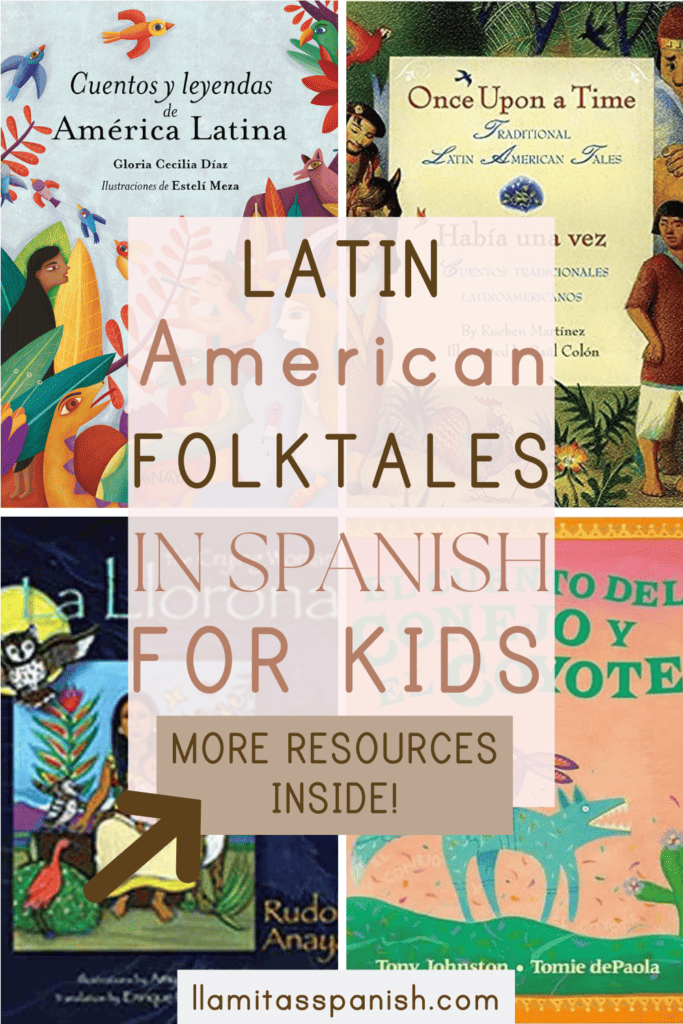
Traditional Folk Tales from Latin America and Spain
To help you keep your little linguists entertained, we’ve compiled a list of our 10 Top Folktales from Spain and Latin America for children.
La Llorona (The Crying Woman)
La Llorona is a folktale that originates in Spain, but has made its way to many countries across Latin America, particularly Mexico and Central America.
This Spanish folktale tells the story of a young mother whose children accidentally drown due to her carelessness. Upon realizing that her children have drowned, the crying woman drowns herself.
It is believed that the tortured spirit of this broken-hearted mother wanders the Earth looking for her children. At night, it is said that her cries may be heard in places close to lakes and rivers.
La Llorona is believed to wander around at night crying for her lost children and kidnapping living children. Parents warn their kids not to wander around in the dark or they may be kidnapped by La Llorona.
El Cuco/El Coco (The Boogeyman)
El Cuco (sometimes referred to as El Coco) is the Spanish and Latin American version of the Boogeyman.
This is another story that has made its way from Spain across most of Latin America, and most Spanish-speaking children have at some time in their life been frightened by the idea that El Cuco will hide under their bed at night and kidnap them.
El Cuco is said to kidnap children who misbehave, so children are often admonished to behave properly “para que no te lleve el Cuco”.
La Cucarachita Martina (Martina the Cockroach)
This Spanish folktale comes to us from Spain, but became particularly popular in the Spanish-speaking Caribbean, with different versions of it showing up in Cuba, Puerto Rico, and the Dominican Republic.
It tells the story of a beautiful cockroach who is looking for a suitable mate. As she goes through a series of suitors, the choosy cockroach discovers the importance of sticking to your standards when selecting the perfect life partner.
El Puma y el Saltamontes (The Mountain Lion and the Grasshopper)
This Latin American folktale from Mexico tells the story of black mountain lion who learned a lesson from a grasshopper. El puma was so intimidating to his fellow animals that he became a kind of bully, and soon all the other animals began growing tired of his behavior.
One day, as el puma was running through the jungle, he ran over a grasshopper’s house and destroyed it. The saltamontes became very upset and scolded the puma because of his reckless behavior.
Because the puma refused to apologize, the grasshopper challenged him to a battle. While the puma gathered an army of foxes, the saltamontes organized an army of insects.
Once the army of insects unleashed their team of wasps, the mountain lion soon learned that the size of an animal does not determine its power or strength. Soon the puma apologized to the grasshopper and the two became the best of friends.
La Mazorca de Oro (The golden corn cob)
This folktale from Perú tells the story of a humble family with five children and a father who didn’t carry his weight in the household.
The family was very poor and the burden of maintaining the family fell entirely on the mother, who worked in the fields planting and harvesting corn while her husband slept the day away.
Soon the mother became so exhausted from overworking, that she was unable to gather enough corn to feed her children, and she fell into a deep sleep.
The next day she awoke and found a magical corn cob made of solid gold in her cornfield. Upon seeing this miracle, the husband mended his ways and the family was able to provide for their needs by selling the golden corn cob.
Anahí y la Flor de Ceibo (Anahí and the Ceibo flower)
This beloved folktale from Argentina tells the story of a young, courageous guaraní woman named Anahí who lived by the Paraná River.
Anahí, along with others from her village, was taken captive by Spanish conquistadors when the Spanish arrived in Argentina. One night, the young Anahí escaped, but she was caught and punished by the Spaniards.
On the day that she was to be executed, they tied Anahí to a tree, but she began to sing and the magic of her voice transformed her into the tree itself!
As a sign of her purity and courage, the tree immediately bloomed and was soon covered entirely in red flowers. This flower, known as the Ceibo, became Argentina’s national flower and recalls the legend of Anahí, a symbol of courage and strength for the people of Argentina.
San Jorge y el Dragón (St. George and the Dragon)
This famous folktale from the Aragón region of Spain has been passed down for centuries since the Middle Ages, and has spread throughout all of Latin America in some form.
The story tells of a dangerous dragon that was terrorizing an entire kingdom. To placate the dragon, the villagers offered a human sacrifice daily.
One day, the King’s daughter was selected to become the next sacrifice. It is said that St. George slayed the dragon and rescued the princess.
From the dragon’s blood, a giant rosebush grew, which St. Jorge offered to the princess. This is where the tradition of offering a red rose to the object of your affection comes from.
El Conejo en la Luna (The rabbit on the moon)
This Mexican folktale tells the story of the Mayan God Quetzalcoatl, who decided to visit the material world in human form.
After climbing many mountains, trekking through many forests, and discovering the earthly world, Quetzalcoatl grew tired and decided to rest upon a rock from which he could gaze upon the brilliant, colorful sky.
Soon Quetzalcoatl saw a small rabbit munching on some grass beside him. When Quetzalcoatl asked the rabbit what he was eating, the rabbit offered him some. Quetzalcoatl refused the rabbit’s offering and explained that humans don’t eat grass.
So the rabbit offered to become the god’s next meal, noting that he looked tired and hungry. Moved by the animal’s kindness and willingness to sacrifice himself, Quetzalcoatl befriended the rabbit and took him to the moon, stamped his image on the surface of the moon, and brought him back down to earth.
This is why, to this day, if you look up at moon on a clear night, you can see the image of the rabbit stamped upon the moon.
El Coyote y el Conejo (The Coyote and the Rabbit)
In this delightful folk tale from Mexico we get to know one ingenious rabbit who outsmarted a coyote and saved his own life in the process!
By offering the coyote a series of other options to distract him, the smart little rabbit manages to escape without becoming the coyote’s next meal.
La Leyenda de los Volcanes Popocatepetl e Iztaccihuatl
This mystical tale dating back to the Aztec civilization in Mexico tells of and Aztec prince named Popocatepetl who fell in love with the daughter of an Aztec chief named Iztaccihuatl.
Iztaccihuatl was very beautiful and had many suitors, although her heart belonged only to Popocatepetl.
When Popocatepetl went away to war, he promised to return for her at then end of the battle. But while Popocatepetl was away at war, one of his rivals started a rumor that Popocatepetl had been killed in battle. This news broke Iztaccihuatl’s heart and she became so devastated that she took her own life.
Once Popocatepl returned home and found his loved one gone, he too died of a broken heart. So moved were the Aztec Gods by their love story, that both of their souls were transformed into Mexico’s tallest volcanoes, Volcán Popocatepetl y Volcán Iztaccihuatl, two mountains who stand facing one another to this day in memory of the lovers.
A retelling of this story is featured in our level 2 curriculum!
Traditional Spanish Folktale Anthologies
When you enroll in our Llamitas Spanish Level 2 Curriculum, you receive access to our very own folktales anthology: “Antología de cuentos y leyendas” with six beautifully illustrated stories.
To discover dozens of Latin American and Spanish folktales, you may enjoy these anthologies that we highly recommend.
Cuentos y leyendas de América Latina
This beautifully illustrated anthology includes folktales like from 20 Latin American countries including the widely known stories of La Llorona and Quetzalcóatl y el maíz, as well as gems like La Madremonte and La flor de Lirolay.
With over 40 short folktales, this is the perfect anthology for intermediate to advanced Spanish readers.
Había una vez: cuentos tradicionales latinoamericanos
For a bilingual option, we love this collection of Traditional Latin American Tales in English and Spanish.
This is a shorter collection with just 7 stories including El gallo de bodas and La flor de lirolay.
The stories are longer with English on one page and Spanish on the other. It’s the perfect option for all levels.
All of these materials provide excellent supplemental education when used alongside our our comprehensive Llamita Spanish Curriculum.


